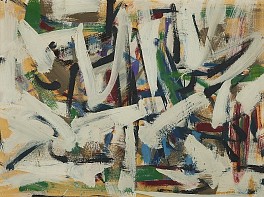BIOGRAPHY

French-Canadian, 1923-2002
Jean-Paul Riopelle (1923-2002) was one of Canada's most celebrated modern artists and an important figure in postwar French art. Living in France during the most productive decades of his career, Mr. Riopelle practiced a European variant of American Abstract Expressionism. He was inspired in the mid-1940's by the Surrealist idea of automatism -- painting intuitively without preconceived images or compositional ideas -- to create expansive, allover fields of gestural mark-making.
Riopelle's talent was recognized early. In 1948, at age 25, he had his first exhibition when he was included in Exposition internationale du surréalisme (International exhibition of Surrealism) at Galerie Maeght, Zurich, organized by André Breton and Marcel Duchamp and now considered the last major show of the Surrealist movement. He had his first U.S. solo show in 1954 at the Pierre Matisse Gallery, New York.
His early, wildly expressionistic work was compared to that of Jackson Pollock, but in the early 1950's Mr. Riopelle began painting more methodically, using palette knives to build up thick, patchy surfaces in saturated colors, creating effects suggestive of stained glass and mosaics.
From the late 1950s Riopelle lived and worked near Giverny with the American painter Joan Mitchell, who had similarly traveled to France in the post–World War II period, settling in Paris after 1955. Their work from the 1960s, especially, shows their mutual influence on each other.
His works from the 50s, of which this work is one, are considered among his best works.
His works are included in numerous public collections, including the Guggenheim, MOMA, the Pompidou Center, the Hirshhorn and numerous other museum collections.
